Unit 1 Tales of the unexplained Period Two Word power Grammar and usage (共26张PPT)
文档属性
| 名称 | Unit 1 Tales of the unexplained Period Two Word power Grammar and usage (共26张PPT) |  | |
| 格式 | zip | ||
| 文件大小 | 3.7MB | ||
| 资源类型 | 教案 | ||
| 版本资源 | 牛津译林版 | ||
| 科目 | 英语 | ||
| 更新时间 | 2017-11-20 08:21:34 | ||
图片预览


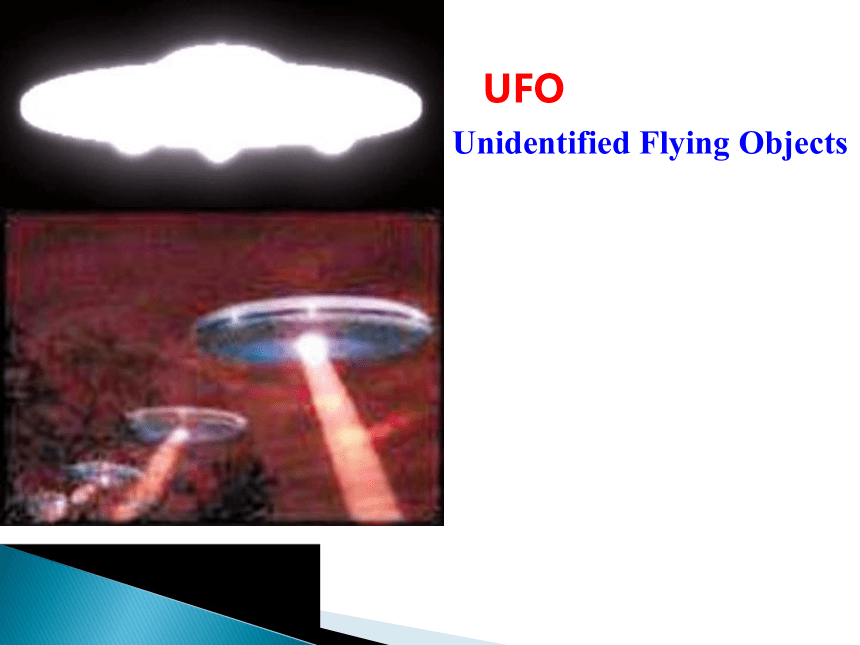

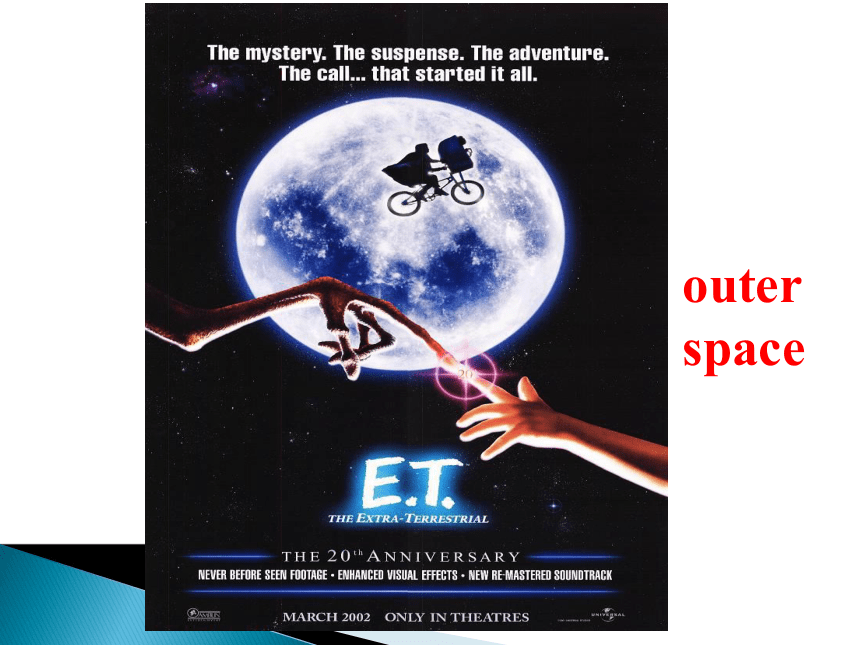

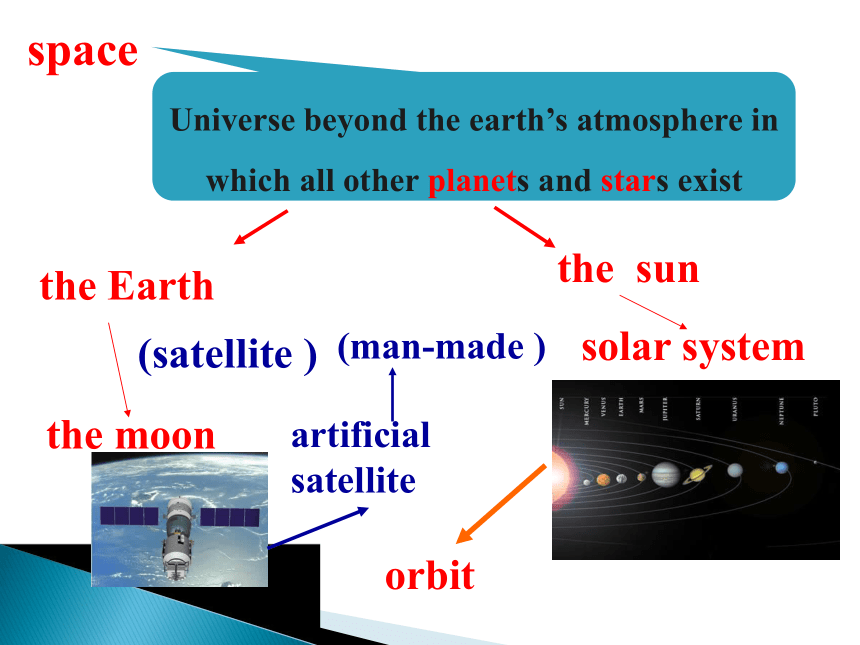
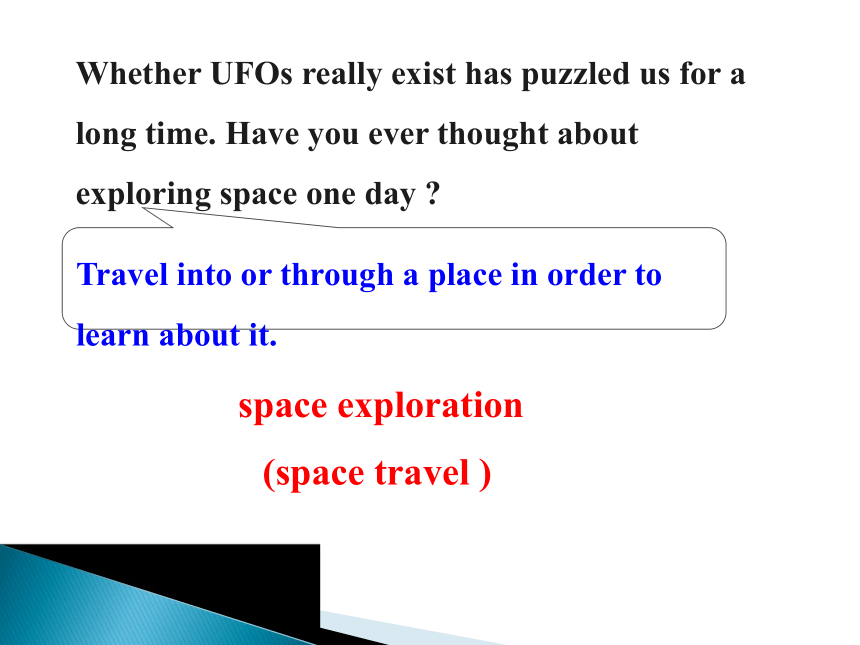
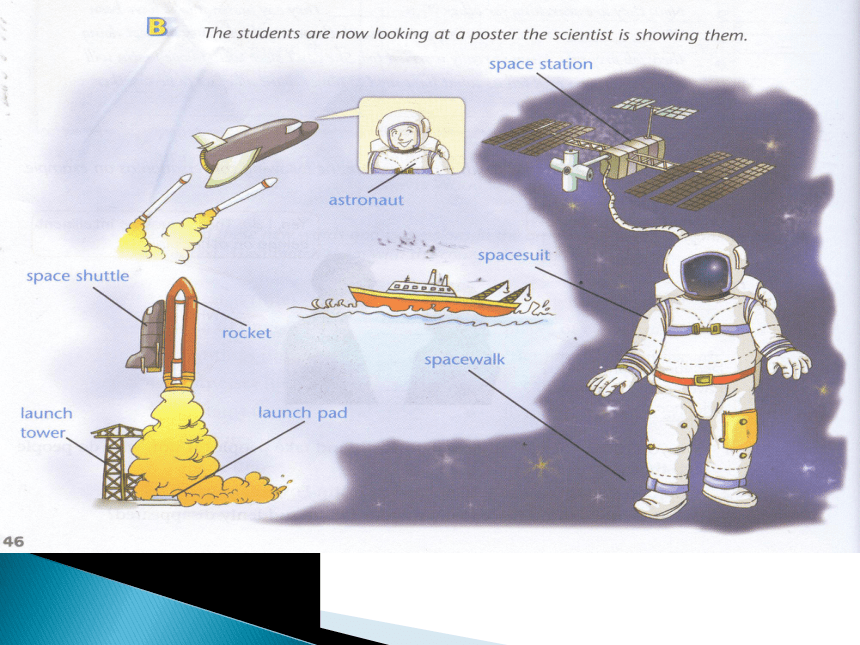
文档简介
课件26张PPT。
Unit 1 Tales of the unexplainedWord powerUnidentified Flying ObjectsUFOaliens outer spaceBrainstorming space Universe beyond the earth’s atmosphere in which all other planets and stars existthe Earth the sunthe moon(satellite )artificial satellitesolar system orbit (man-made )Whether UFOs really exist has puzzled us for a long time. Have you ever thought about exploring space one day ?Travel into or through a place in order to learn about it.space exploration (space travel )Who is he ?Do you know where he is ?He is Yang Liwei, and he is an astronaut . spaceman / spacewoman space shuttle Shenzhou 5
manned spaceshipspace shuttle unmanned spaceshipPlacing a satellite into orbit requires a large amount of energy, which must come from the launch vehicle, or device that launches the satellite. The satellite needs to reach an altitude of at least 200 km (120 mi) and a speed of over 29,000 km/h (18,000 mph) to lift into orbit successfully. Satellites receive this combination of potential(势能) energy (altitude) and kinetic(动能) energy (speed) from multistage rockets burning chemical fuels.Apollo Eleven Countdown A rocket launch countdown. A common sound in the nineteen-sixties. But this was not just another launch. It was the beginning of an historic event. It was the countdown for Apollo Eleven -- the space flight that would carry men to the first landing on the moon. Two-and-one-half minutes after the Apollo Eleven launch, the first-stage rocket separated from the spacecraft. Twelve minutes later, the spacecraft reached orbit. Its speed was twenty-nine-thousand kilometers an hour. Its orbit was one-hundred-sixty-five kilometers above the Earth. This was the time for the crew to test all the spacecraft systems. Everything worked perfectly. So, the NASA flight director told them they were "go" for the moon. They fired the third-stage rocket. It increased the speed of the spacecraft to forty-thousand kilometers an hour. This was fast enough to escape the pull of the Earth's gravity.
Apollo Eleven was on its way to the moon. In seventy-seven hours, if all went well, Apollo Eleven would be there. On July 20, 1969, American astronaut Edwin "Buzz" Aldrin, Jr. (pictured) became the second person to walk on the moon. Aldrin stepped onto the moon shortly after fellow Apollo 11 astronaut, Neil Armstrong. While millions of people on earth watched a televised broadcast of the event, Armstrong and Aldrin spent two hours exploring the lunar surface, gathering samples, taking photos, and setting up experiments. spaceship/spacecraftspace shuttle space station spacespacesuitspacewalk astronaut (spaceman/spacewoman)space explorationA. Person who travels in outer space B. Large manned artificial satellite used as a base for operations in space, e.g. for scientific research …C. Vehicle manned or unmanned for traveling in space D. Sealed suit covering the whole body and supplied with air , allowing the wearer to move about in space E. Manned spaceship designed for repeated use, e.g. between Earth and a space station or the moon …F. The exploration of space ,traveling into space in order to learn about it G. Action of moving about in space outside a spacecraft Explanation H. Universe beyond the Earth’s atmosphere
in which all other planets and stars existI guess some of you are dreaming of becoming an ________ and travelling to _______ to carry out ______________ . If this comes true , you’ll probably travel by ___________ , a spaceship that looks like an aeroplane . Two ________ supported by a launch tower will lift the space shuttle into space . Some time after the rockets and the space shuttle are ________ ,the rockets will separate from the space shuttle and fall into the sea. astronaut space space explorationspace shuttle rockets launched ConsolidationThen a ship will pick them up. Astronauts will do their research in a base in outer space called ____________ . Sometimes they go out of their space shuttle to take a _________. In outer space astronauts cannot take off their ________ , which protect them and provide oxygen . In 1965, Alexei Leonov from the former Soviet Union became the first human being to take a walk in space.space stationspacewalkspacesuits The ancient Greeks called them “planetes.” (PLAN-ee – teess ). The word means wanderer -- one who moves from place to place with no home.
On a dark, clear night, away from the lights of a city, you can still find the five wanderers using only your eyes. However they are no longer mysteries. Today we know them as Saturn, Jupiter, Venus, Mercury and the closest planet to Earth, the red planet, Mars.Extension outer Nine planets 水星(Mercury)
金星(Venus)
地球(Earth)
火星(Mars)
木星(Jupiter)
土星(Saturn)
天王星(Uranus)
海王星(Neptune)
冥王星(Pluto) Earth, of course, can be studied without the aid of spacecraft. Nevertheless it was not until the twentieth century that we had maps of the entire planet. Pictures of the planet taken from space are of considerable importance;orbit: 149,600,000 km from Sun
diameter(直径): 12,756.3 km mass(质量): 5.972e24 kg Earth is the third planet from the Sun and the fifth largest: Discussion If you have a chance to travel in space, which planet do you want to go ?why?
How would you like to go there ?If you want to know more information, you can surf the internet :
www.space-exploration.org
www.foodmate.net/tingroom
www.nineplanets.org
manned spaceshipspace shuttle unmanned spaceshipPlacing a satellite into orbit requires a large amount of energy, which must come from the launch vehicle, or device that launches the satellite. The satellite needs to reach an altitude of at least 200 km (120 mi) and a speed of over 29,000 km/h (18,000 mph) to lift into orbit successfully. Satellites receive this combination of potential(势能) energy (altitude) and kinetic(动能) energy (speed) from multistage rockets burning chemical fuels.Apollo Eleven Countdown A rocket launch countdown. A common sound in the nineteen-sixties. But this was not just another launch. It was the beginning of an historic event. It was the countdown for Apollo Eleven -- the space flight that would carry men to the first landing on the moon. Two-and-one-half minutes after the Apollo Eleven launch, the first-stage rocket separated from the spacecraft. Twelve minutes later, the spacecraft reached orbit. Its speed was twenty-nine-thousand kilometers an hour. Its orbit was one-hundred-sixty-five kilometers above the Earth. This was the time for the crew to test all the spacecraft systems. Everything worked perfectly. So, the NASA flight director told them they were "go" for the moon. They fired the third-stage rocket. It increased the speed of the spacecraft to forty-thousand kilometers an hour. This was fast enough to escape the pull of the Earth's gravity.
Apollo Eleven was on its way to the moon. In seventy-seven hours, if all went well, Apollo Eleven would be there. On July 20, 1969, American astronaut Edwin "Buzz" Aldrin, Jr. (pictured) became the second person to walk on the moon. Aldrin stepped onto the moon shortly after fellow Apollo 11 astronaut, Neil Armstrong. While millions of people on earth watched a televised broadcast of the event, Armstrong and Aldrin spent two hours exploring the lunar surface, gathering samples, taking photos, and setting up experiments. spaceship/spacecraftspace shuttle space station spacespacesuitspacewalk astronaut (spaceman/spacewoman)space explorationA. Person who travels in outer space B. Large manned artificial satellite used as a base for operations in space, e.g. for scientific research …C. Vehicle manned or unmanned for traveling in space D. Sealed suit covering the whole body and supplied with air , allowing the wearer to move about in space E. Manned spaceship designed for repeated use, e.g. between Earth and a space station or the moon …F. The exploration of space ,traveling into space in order to learn about it G. Action of moving about in space outside a spacecraft Explanation H. Universe beyond the Earth’s atmosphere
in which all other planets and stars existI guess some of you are dreaming of becoming an ________ and travelling to _______ to carry out ______________ . If this comes true , you’ll probably travel by ___________ , a spaceship that looks like an aeroplane . Two ________ supported by a launch tower will lift the space shuttle into space . Some time after the rockets and the space shuttle are ________ ,the rockets will separate from the space shuttle and fall into the sea. astronaut space space explorationspace shuttle rockets launched ConsolidationThen a ship will pick them up. Astronauts will do their research in a base in outer space called ____________ . Sometimes they go out of their space shuttle to take a _________. In outer space astronauts cannot take off their ________ , which protect them and provide oxygen . In 1965, Alexei Leonov from the former Soviet Union became the first human being to take a walk in space.space stationspacewalkspacesuits The ancient Greeks called them “planetes.” (PLAN-ee – teess ). The word means wanderer -- one who moves from place to place with no home.
On a dark, clear night, away from the lights of a city, you can still find the five wanderers using only your eyes. However they are no longer mysteries. Today we know them as Saturn, Jupiter, Venus, Mercury and the closest planet to Earth, the red planet, Mars.Extension outer Nine planets 水星(Mercury)
金星(Venus)
地球(Earth)
火星(Mars)
木星(Jupiter)
土星(Saturn)
天王星(Uranus)
海王星(Neptune)
冥王星(Pluto) Earth, of course, can be studied without the aid of spacecraft. Nevertheless it was not until the twentieth century that we had maps of the entire planet. Pictures of the planet taken from space are of considerable importance;orbit: 149,600,000 km from Sun
diameter(直径): 12,756.3 km mass(质量): 5.972e24 kg Earth is the third planet from the Sun and the fifth largest: Discussion If you have a chance to travel in space, which planet do you want to go ?why?
How would you like to go there ?If you want to know more information, you can surf the internet :
www.space-exploration.org
www.foodmate.net/tingroom
www.nineplanets.org
